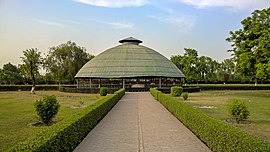Vaishali
Vaiśālī Licchavi | |
|---|---|
| Coordinates: 25°59′N 85°08′E / 25.99°N 85.13°E | |
| Country | |
| State | Bihar |
| Region | Mithila |
| District | Vaishali |
| Established | 599 BCE |
| Time zone | UTC+5:30 (IST) |
| Pilgrimage to |
| Buddha's Holy Sites |
|---|
 |
Vaishali, Vesali or Vaiśālī was a city in present-day Bihar, India, and is now an archaeological site. It is a part of the Tirhut Division.[1]
It was the capital city of the Vajjika League of Vrijji mahajanapada, considered one of the first examples of a republic around the 6th century BCE. Gautama Buddha preached his last sermon before his death in c. 483 BCE, then in 383 BCE the Second Buddhist council was convened here by King Kalasoka, making it an important place in both Jain and Buddhist religions.[2][3] It contains one of the best-preserved of the Pillars of Ashoka, topped by a single Asiatic lion.
Vaishali is also home to possibly the earliest known example of a stupa, the Buddha relic stupa which is said to contain the ashes of the Buddha.[4][5]
The city finds mention in the travel accounts of Chinese explorers, Faxian (4th century CE) and Xuanzang (7th century CE), which were later used in 1861 by British archaeologist Alexander Cunningham to first identify Vaiśālī with the present village of Basarh in Vaishali District, Bihar.[6][7]
- ^ "Tirhut Division". tirhut-muzaffarpur.bih.nic.in. Archived from the original on 16 March 2015. Retrieved 26 December 2019.
- ^ Hoiberg, Dale; Indu Ramchandani (2000). Students' Britannica India, Volumes 1-5. Popular Prakashan. p. 208. ISBN 0-85229-760-2. Archived from the original on 4 May 2021. Retrieved 28 June 2021.
- ^ Kulke, Hermann; Dietmar Rothermund (2004). A history of India. Routledge. p. 57. ISBN 0-415-32919-1. Archived from the original on 28 June 2021. Retrieved 28 June 2021.
- ^ Fogelin, Lars (2015). An Archaeological History of Indian Buddhism. Oxford University Press. p. 85. ISBN 9780199948239.
- ^ Lahiri, Nayanjot (2015). Ashoka in Ancient India. Harvard University Press. pp. 246–247. ISBN 9780674057777.
- ^ Janice Leoshko (2017). Sacred Traces: British Explorations of Buddhism in South Asia. Taylor & Francis. p. 74. ISBN 978-1-351-55030-7. Archived from the original on 27 June 2021. Retrieved 28 June 2021.
- ^ Dilip Kumar (1986). Archaeology of Vaishali. Ramanand Vidya Bhawan. p. 36. ISBN 9788185205083. OCLC 18520132. Archived from the original on 27 June 2021. Retrieved 28 June 2021.




